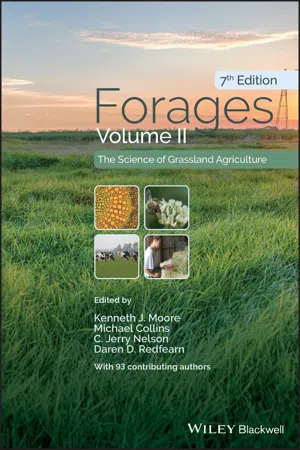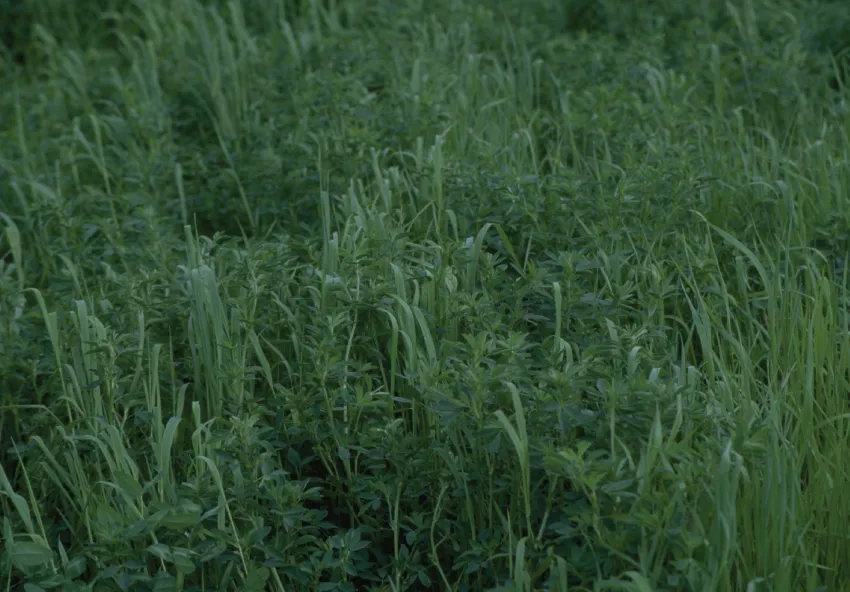
eBook - ePub
Forages, Volume 2
The Science of Grassland Agriculture
- English
- ePUB (mobile friendly)
- Available on iOS & Android
eBook - ePub
Forages, Volume 2
The Science of Grassland Agriculture
About this book
Forages: The Science of Grassland Agriculture, 7th Edition, Volume II will extensively evaluate the current knowledge and information on forage agriculture. Chapterswritten by leading researchers and authorities in grassland agriculture are aggregated under section themes, each one representing a major topic within grassland science and agriculture.This 7th edition will include two new additional chapters covering all aspects of forage physiologyin three separate chapters, instead of one in previous editions.Chapters will be updated throughout toinclude new information that has developed since the last edition. Thisnew editionof the classic referenceserves as a comprehensive supplement to An Introduction to Grassland Agriculture, Volume I.
Frequently asked questions
Yes, you can cancel anytime from the Subscription tab in your account settings on the Perlego website. Your subscription will stay active until the end of your current billing period. Learn how to cancel your subscription.
At the moment all of our mobile-responsive ePub books are available to download via the app. Most of our PDFs are also available to download and we're working on making the final remaining ones downloadable now. Learn more here.
Perlego offers two plans: Essential and Complete
- Essential is ideal for learners and professionals who enjoy exploring a wide range of subjects. Access the Essential Library with 800,000+ trusted titles and best-sellers across business, personal growth, and the humanities. Includes unlimited reading time and Standard Read Aloud voice.
- Complete: Perfect for advanced learners and researchers needing full, unrestricted access. Unlock 1.4M+ books across hundreds of subjects, including academic and specialized titles. The Complete Plan also includes advanced features like Premium Read Aloud and Research Assistant.
We are an online textbook subscription service, where you can get access to an entire online library for less than the price of a single book per month. With over 1 million books across 1000+ topics, we’ve got you covered! Learn more here.
Look out for the read-aloud symbol on your next book to see if you can listen to it. The read-aloud tool reads text aloud for you, highlighting the text as it is being read. You can pause it, speed it up and slow it down. Learn more here.
Yes! You can use the Perlego app on both iOS or Android devices to read anytime, anywhere — even offline. Perfect for commutes or when you’re on the go.
Please note we cannot support devices running on iOS 13 and Android 7 or earlier. Learn more about using the app.
Please note we cannot support devices running on iOS 13 and Android 7 or earlier. Learn more about using the app.
Yes, you can access Forages, Volume 2 by Kenneth J. Moore, Michael Collins, C. Jerry Nelson, Daren D. Redfearn, Kenneth J. Moore,Michael Collins,C. Jerry Nelson,Daren D. Redfearn in PDF and/or ePUB format, as well as other popular books in Technology & Engineering & Agriculture. We have over one million books available in our catalogue for you to explore.
Information
PART I
FORAGE PLANTS

A mixed stand of alfalfa and timothy. Timothy mixtures with alfalfa in Kentucky provide mixed forage on the first cutting or grazing but nearly pure alfalfa through the remainder of the growing season.
Source: Photo courtesy of Mike Collins.
Part I covers basic physiologic and physical properties of forage species at the cellular and whole‐plant levels that guide genetic improvement and underscore management practices. The goals are to improve yield and quality of the biomass and resistance to biotic and abiotic stresses. These processes often have negative correlations that are species dependent, and responses of spaced‐plants may not reflect their properties when grown in dense stands or mixtures. Critical topics such as photosynthesis, root growth, canopy architecture, lignification of cell walls and presence of antiquality factors such as alkaloids in leaves need to continue to be evaluated. Most perennial forage plants are polyploids and cross‐pollinated, making it difficult to identify and transfer genes using biotechnology, but CRISPR‐Cas9 and other new technologies are opening new ways to supplement traditional breeding methods.
Genetic potential for growth and persistence set the upper limits for yield. Management strategies utilize resources efficiently to achieve the actual annual yield, but it rarely nears the genetic potential. Reducing the yield gap by more intense management may not be economically feasible or environmentally friendly. Thus, increasing efficiency of energy, radiation, nutrient, water and other natural resources are objectives. These processes are integrated to understand and optimize plant growth, flowering and seed development. The integrated system is what the manager must understand to achieve the desired objective in a way that is sustainable for now and the future.
CHAPTER 1
Perspectives, Terminology, and Classification
C. Jerry Nelson, Professor Emeritus, Kenneth J. Moore, Distinguished Professor, Michael Collins, Professor Emeritus, and Daren D. Redfearn, Associate Professor
Plant Sciences, University of Missouri, Columbia, MO, USA
Agronomy, Iowa State University, Ames, IA, USA
Plant Sciences, University of Missouri, Columbia, MO, USA
Agronomy, University of Nebraska, Lincoln, NE, USA
As it has for millennia, the earth is changing physically, especially during the past few decades, while human population is growing very rapidly. Forage management has advanced to help meet the expanding needs for ruminant animal products, nitrogen acquisition, fuel resources and environmental stewardship. However, changes in climate, conflicts and shortages of water supplies, increased public emphasis on ecosystem management, and the challenges of world hunger and energy remain in the news almost daily. Other concerns include food safety, food quality and animal welfare. Each raises questions about how to deal with hunger, the environment and quality of human life; especially how management of pastures, forage fields and the products they support can help provide solutions.
Need for Consistent Terminology
Clear communication depends on terminology that is common among the individuals involved. Many terms are common to production of all crops and animals. In this book, however, emphasis is on those terms unique to forage crops, pastures, range, and livestock that describe their underlying science and practical use. Terms in bold face are defined in a comprehensive glossary in the appendix.
While many terms have a history of usage, they can be confusing when moved from one culture or location to another. New terms appear regularly along with new technologies, and need to be clear and used correctly. For example, a few years ago, a drone would have referred to a male bee, which it still does, but with the advent of precision agriculture, a drone is also now an unmanned aircraft guided by remote control or onboard computers using global positioning systems (GPSs). Drones can carry instruments that measure plant health, forage quality, forage production and monitor animal behavior in a pasture. Many other applications will soon follow.
Most definitions are written for the practitioner and may not be fully understood by the general public or policy makers. Practitioners are more aware than the public or legislators about the intrinsic values of forages and grasslands. They have a vested interest in technical and economic aspects that help them be better managers or marketers. Some specific or technical terms for communication among researchers are in the glossary for use by practitioners involved with technical communications. Scientists, extension specialists, consultants, and journalists need to be aware of differences in knowledge levels between practitioners and the public, especially in urban areas.
Terms in Grassland Management
Professionals in forages and grasslands have responsibility to develop consistency of definitions so communication is clear. Endophyte‐free or E− tall fescue, glandular‐haired alfalfa, and no‐till seeding are terms that are becoming common. Conversely, there is debate as to what constitutes animal ...
Table of contents
- Cover
- Table of Contents
- In Praise of Grass
- Grassland Science
- Preface
- List of Contributors
- Dedication
- PART I: FORAGE PLANTS
- PART II: FORAGE ECOLOGY
- PART III: FORAGE SPECIES
- PART IV: FORAGE SYSTEMS
- PART V: FORAGE PRODUCTION AND MANAGEMENT
- PART VI: FORAGE IMPROVEMENT
- PART VII: FORAGE QUALITY
- PART VIII: FORAGE HARVESTING AND UTILIZATION
- PART IX: PASTURE MANAGEMENT
- Common and Scientific Names of Forages
- Glossary
- Index
- End User License Agreement